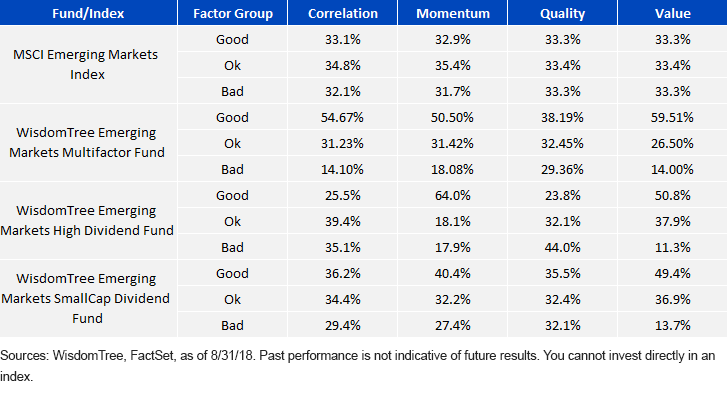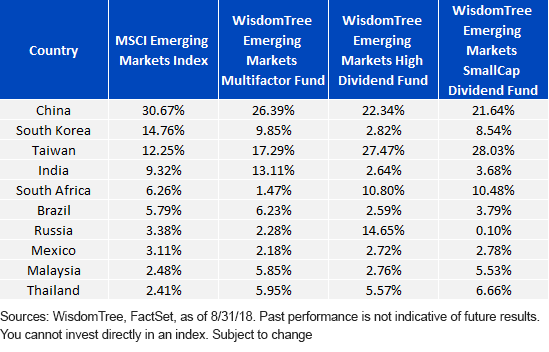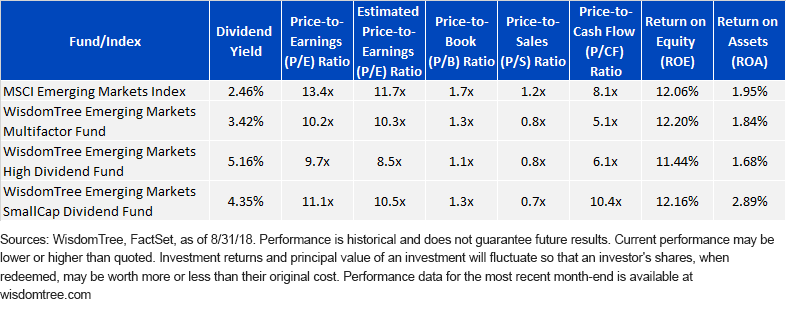A Comparison of Our Emerging Markets Approaches


One of my Twitter followers asked how our new emerging markets multifactor exchange-traded fund (ETF), the WisdomTree Emerging Markets Multifactor Fund (EMMF), compares with some of our existing emerging market funds in terms of portfolio characteristics, geographies, factor tilts and expected value added.
Let me see if I can address each of these questions in turn.
One of our best-performing Funds since we launched it over a decade ago is the WisdomTree Emerging Markets SmallCap Dividend Fund (DGS), which has outperformed its cap-weighted benchmark, net of fees, by over 150 basis points (bps) a year for more than a decade. When comparing it with the broad large-cap index, the outperformance is greater than 230 bps.1
When we look at performance drivers over this period, this emerging market small-cap Fund shifts weight to both the highest dividend segment of the market and toward higher quality—meaning more-profitable stocks. Both tilts have paid off nicely and show one of the biggest risk factors in emerging markets is unprofitable companies that cannot afford dividends.
- The evidence: zero-dividend stocks declined 2.6% per year for over a decade while the highest quintile of dividend-yield stocks in the MSCI Emerging Markets Small Cap Dividend Index (MXEFSC) returned nearly 9.0%. Our Fund allocated about 40% to the highest quintile while the cap-weighted index allocated less than 15%—and this big over-weight was the preponderance of the outperformance. The other significant driver came from the under-weight to the non dividend-payers. This category had a large decline but, in the cap-weighted index, was 18% of the portfolio, while our Fund starts with a requirement to pay a dividend.
- The spread on quality metrics such as return on equity was even higher—with the unprofitable companies losing 4.7% a year while the highest quintile for profitability was returning +7.0% per year. The quality tilt is indirect from the dividend-paying tilt, but one can still see a meaningful shift of almost 7% more to the top quintile and 7% under-weight in negative earners and the bottom quintile combined.


While we believe this dividend fund methodology works very well, our new multifactor ETF has a different way of calculating value exposure—dividend yield is not one of the value factors; the Fund is more earnings-based, as we described in a recent post. Our new value factor sort is also being applied within sectors instead of at an absolute level.
In our dividend-weighted strategies, if a Utility stock has a persistently higher dividend yield than an Information Technology stock, we will be forever under-weight in Technology and over-weight in Utilities. With the new value grading methodology in our multifactor process, we are scoring stocks within sectors so we will have less bias there in terms of persistent low-valuation sectors.
Quality tilts to more-profitable companies typically come with dividends like we saw above, but there is no accounting for changes in profitability levels and earnings momentum in terms of how that affects profitability ratios. That is something our new multifactor process aims to achieve in a multidimensional quality score.
Also new is momentum as a factor for our approaches—which is largely absent in our dividend Fund methodology; if anything, our methodology is anti-momentum with the valuation-sensitive re-balancing.
The WisdomTree Factor Quilt
Below, we look at what we call the WisdomTree factor quilt—which has good/OK/bad categorizations across each of the four factors in our multifactor process. The market, by definition of the grouping assignments, has one-third allocated across each of the good/OK/bad groupings.
The section below will look at factor expressions, sector tilts, country weights and valuations across our two dividend Funds and this new multifactor Fund.
- We often describe the WisdomTree Emerging Markets High Dividend Fund (DEM) as one of our deepest value-tilted Funds because it sports a price-to-earnings (P/E) ratio below 10x. Using this new definition of value (which has some sector neutrality adjustments baked into it), it has 51% of its weight in “good value” stocks, whereas our new multifactor Fund has even more allocated to good value-stocks—59.51%. Both Funds have a similarly low aggregate P/E ratio, showing that both are expressions of a value tilt.
- On momentum, right now DEM—not by a direct inclusion of momentum in its process but just those stocks showing momentum—actually has the highest tilt to good momentum stocks at 64% of weight in the best momentum stocks, whereas the multifactor Fund has 51%—a large tilt as well.
- While some of the factor tilts are larger, quality was one of lower tilts in EMMF at 38.2%—the high-dividend Fund only has 24% in the good quality stocks on our new quality measure.
- Correlation: EMMF has a strong tilt to less-correlated stocks, with 55% exposure in the lowest-correlation stocks, almost a 30% shift more than the high-dividend Fund, which had only 25.5% there. Small caps were closer to market exposure on the correlation factor, as with several of the other factors.

On a sector basis, we can see the new WisdomTree Emerging Markets Multifactor Fund constrains its sector tilts to within 5% bands of the broader MSCI Emerging Markets Index. Currently, there is a tilt toward Consumer Staples and Health Care and a tilt away from Financials and Information Technology. Neither dividend Fund has the same sector constraint, so there can be large tilts, and the high-dividend fund has a particular focus today on Energy and Materials—a big tilt toward the Commodity sector and away from Information Technology. The small-cap Fund has little Energy, but more Consumer Discretionary and Real Estate and less Financials.

On a country basis, the 5% bands are evident when looking at the top 10 country exposures. The WisdomTree Emerging Markets High Dividend Fund and the WisdomTree Emerging Markets SmallCap Dividend Fund have notable shifts in countries toward Taiwan and South Africa and away from South Korea and India. The new WisdomTree Emerging Markets Multifactor Fund also is over-weight in Taiwan, but at 5% because of its constraint. The Fund is also over-weight in India and under-weight in South Africa.

Rolling all these tilts into valuations, one can see some of the key valuation characteristics across these funds.

Please click each respective Funds ticker for the standardized performance of each Fund: EMMF, DGS, DEM.
For definitions of terms in the chart, please visit our glossary.
Finally, the hardest question concerns what our expected value-added is from our multifactor process. Our new multifactor Funds were designed to be some of the highest alpha-seeking Funds we created, with higher active share and high tilts. In the past, our small-cap Fund was already among our highest-value-added Funds for over a decade, with over 150 bps plus performance over its cap-weighted benchmark. We think this new multifactor Fund has potential for that type of performance differential—and perhaps even more if the Fund works as well as the research suggests.
1Source: WisdomTree, FactSet, for the period 11/1/07–7/31/18. The inception date of the WisdomTree Emerging Markets SmallCap Dividend Fund was 10/30/07.
Important Risks Related to this Article
Dividends are not guaranteed, and a company currently paying dividends may cease paying dividends at any time.
Investing involves risk including possible loss of principal. Investments in non-U.S. securities involve political, regulatory and economic risks that may not be present in U.S. securities. For example, foreign securities may be subject to risk of loss due to foreign currency fluctuations, political or economic instability or geographic events that adversely impact issuers of foreign securities. Derivatives used by the Funds to offset exposure to foreign currencies may not perform as intended. There can be no assurance that the Funds’ hedging transactions will be effective. The value of an investment in the Funds could be significantly and negatively impacted if foreign currencies appreciate at the same time that the value of the Funds’ equity holdings falls. Some of the Funds are actively managed using proprietary investment strategies and processes. There can be no guarantee that these strategies and processes will be successful or that the Fund will achieve its investment objective.

Jeremy Schwartz has served as our Global Chief Investment Officer since November 2021 and leads WisdomTree’s investment strategy team in the construction of WisdomTree’s equity Indexes, quantitative active strategies and multi-asset Model Portfolios. Jeremy joined WisdomTree in May 2005 as a Senior Analyst, adding Deputy Director of Research to his responsibilities in February 2007. He served as Director of Research from October 2008 to October 2018 and as Global Head of Research from November 2018 to November 2021. Before joining WisdomTree, he was a head research assistant for Professor Jeremy Siegel and, in 2022, became his co-author on the sixth edition of the book Stocks for the Long Run. Jeremy is also co-author of the Financial Analysts Journal paper “What Happened to the Original Stocks in the S&P 500?” He received his B.S. in economics from The Wharton School of the University of Pennsylvania and hosts the Wharton Business Radio program Behind the Markets on SiriusXM 132. Jeremy is a member of the CFA Society of Philadelphia.

